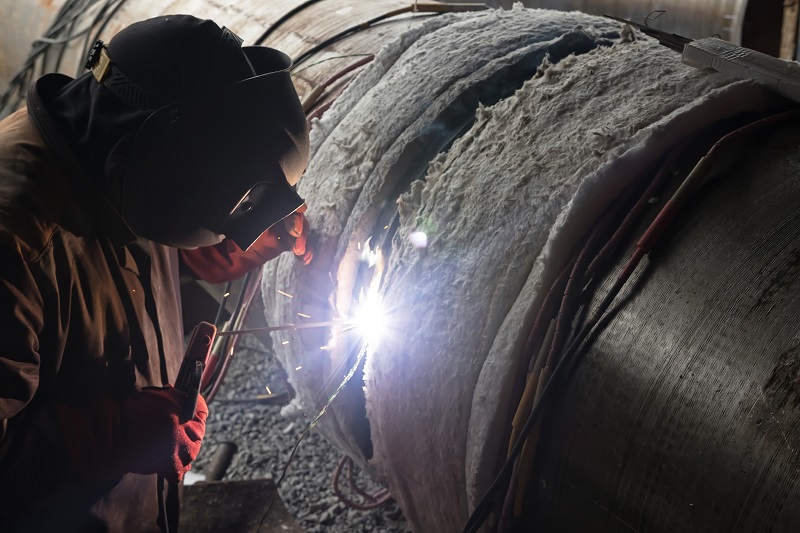Although heat treatment is both a timely and costly operation, it is mandatory in many application codes and standards.
There are a variety of terms that are used to describe the range of heat treatments that can be applied to a welded joint. Each has a very specific meaning…
Solution Treatment
Designed to take into a solution elements and compounds which are then retained in solution, by cooling rapidly from the high solution treatment temperature. Improves corrosion resistance and may also be done to reduce the strength of the joint. May be followed by a lower temperature heat treatment to reform the precipitates in a controlled manner, (age or precipitation hardening) in certain alloys.
Annealing
Consisting of heating a metal to a high temperature , where recrystallisation and/or a phase transformation takes place. It is then cooled slowly, often in a heat treatment furnace. This process is carried out to soften the metal after it has been hardened. Using cold working as an example, a full anneal giving the very softest of microstructures. A reduction in yield and the tensile strength is often noted, and in the case of ferritic steels, usually a reduction in toughness.
Normalising
Carried out only on ferritic steels, it comprises of heating the steel to 30-50°c above the upper transformation temperature, then cooling in still still air. This heat treatment process results in a reduction in grain size with improvements seen in strength and toughness.
Quenching
This heat treatment requires a rapid cool from a high temperature. A ferritic steel would be heated to above the upper transformation temperature, then quenched in water, oil or air blast. Producing a very high strength, fine grained martensite. Steels are always tempered following the quenching process and are never used in quenched condition.
Tempering
Carried out at a relatively low temperature, below the lower transformation temperature on ferritic steels. This process reduces hardness, lowers the tensile strength and improves toughness and ductility. Most normalised steels are tempered before welding, with all quenched being used in the quenched and tempered condition.
Ageing or Precipitation Hardening
Another low temperature heat treatment, designed to produce the correct size and distribution of precipitates. This increases the yield and tensile strength. This heat treatment generally follows a solution heat treatment. Longer times and/or high temperatures result in an increase in size of the precipitate, and both hardness and strength are reduced.
Stress Relief
As the name states, this process is designed to reduce the residual stresses produced by weld shrinkage. As the temperature of the metal is raised, the yield strength decreases. This allows the residual stresses to be redistributed by creep of the weld and the parent metal. Cooling from the stress relief temperature is controlled, to prevent any harmful thermal gradients occurring.
Post Heat
Carried out immediately on completion of welding, it is a low temperature heat treatment. It increases the preheat by 100°c and maintaining this for around 3 or 4 hours. Assisting the diffusion of any hydrogen in the weld or HAZ (Heat Affected Zone) out of the joint. Thus reducing the risk of hydrogen induced cold cracking. Used only where hydrogen cold cracking is a major concern – ferritic steels that are very crack sensitive, very thick joints etc.

Post Weld Heat Treatment
There are three fundamental reasons post weld heat treatment is carried out:
- To achieve dimensional stability in order to maintain tolerances, during machining operations or during shake-down service.
- To produce specific metallurgical structures in order to achieve the required mechanical properties.
- To reduce the risk of in-service problems such as stress corrosion or brittle fracture, by reducing the residual stress in the welded component.
Stress Relieving is one of the main heat treatments for the above objectives.
It is an expensive operation and requires all or part of the welded piece to be heated to a high temperature. It may cause undesirable effects in some alloys.
However, the high residual stress locked into a welded joint, may cause deformation outside acceptable parameters to occur, when the item is machined or when it enters service. High residual stresses in carbon and low alloy steels can increase the risk of brittle fracture.This is by providing a driving force for crack propagation. Residual stresses will cause stress corrosion cracking to occur in the correct environment.
To reduce this level of residual stress, the component is reheated to a sufficiently high temperature. As the temperature is increased the proof strength falls. Thus allowing deformation to occur and residual stress to decrease until an acceptable level is reached. The component would be held at this temperature – known as soaking, for a period of time until a stable condition is reached. It is then cooled back to room temperature. The residual stress remaining in the joint is equal to the proof strength at the soak temperature.
For further information, see the full article from the TWI here, or find out more about applying and controlling heat treatment activities from TWI.
Westermans have a large variety of heat treatment and stress relieving products in stock, click here for machines from AEC and Cooperheat. Alternatively, if you have heat treatment machinery you no longer require, we are always interested to buy for our clients worldwide, send details to Peter Westerman here, or email peter@westermans.com.
